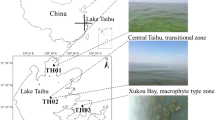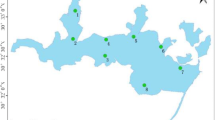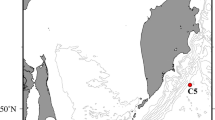Abstract
The objectives of this study were to investigate whether sedimentary iron can promote the growth of cyanobacteria and determine the effects of different forms of iron on cyanobacterial growth. In this study, we simulated cyanobacterial growth in a eutrophic freshwater lake under Fe-deficient conditions using three systems containing artificial lake water and algae (the WA system); artificial lake water and sediment (WS system); and artificial lake water, sediment and algae (the WSA system). Results demonstrate that Fe from sediments did facilitate cyanobacterial growth. Sequential Fe extractions revealed that the majority of sedimentary iron was in the form of reactive iron (80.63%). Furthermore, cellular iron from cyanobacteria and water-soluble Fe in sediments had a strong and significant negative correlation (− 0.792, P < 0.01), indicating that water-soluble Fe in sediments is the most important form of iron for influencing cyanobacterial growth. Further studies on water-soluble Fe mobility showed that up to 47.5% of the released water-soluble Fe could be absorbed into cyanobacterial cells, thereby indicating that water-soluble Fe is significant for cyanobacterial growth and serves as a critical Fe source when lake water iron is limited. In addition, the study found that easily reducible Fe oxide minerals have the largest release potential. These findings provide new insights that could improve management of cyanobacterial blooms.








Similar content being viewed by others
References
Alexova, R., Fujii, M., Birch, D., Cheng, J., Waite, T. D., Ferrari, B. C., & Neilan, B. A. (2011). Iron uptake and toxin synthesis in the bloom-forming Microcystis aeruginosa under iron limitation. Environmental Microbiology, 13(4), 1064–1077.
Barley, M. E., Pickard, A. L., Hagemann, S. G., & Folkert, S. L. (1999). Hydrothermal origin for the 2 billion year old Mount Tom Price giant iron ore deposit, Hamersley Province, Western Australia. Mineralium Deposita, 34(8), 784–789.
Boyd, P. W., Jickells, T., Law, C. S., Blain, S., Boyle, E. A., Buesseler, K. O., Coale, K. H., Cullen, J. J., Baar, H. J. W. D., Follows, M., Harvey, M., Lancelot, C., Levasseur, M., Owens, N. P. J., Pollard, R., Rivkin, R. B., Sarmiento, J., Schoemann, V., Smetacek, V., Takeda, S., Tsuda, A., Turner, S., & Watson, A. J. (2007). Mesoscale iron enrichment experiments 1993–2005: synthesis and future directions. Science, 315, 612–617.
Carey, C. C., Weathers, K. C., & Cottingham, K. L. (2008). Gloeotrichia echinulata blooms in an oligotrophic lake: helpful insights from eutrophic lakes. Journal of Plankton Research, 30, 893–904.
Crockford, L., Jordan, P., Melland, A. R., & Taylor, D. (2015). Storm-triggered, increased supply of sediment-derived phosphorus to the epilimnion in a small freshwater lake. Inland Waters, 5(1), 15–26.
Dang, T. C., Fujii, M., Rose, A. L., Bligh, M., & Waite, T. D. (2012). Characteristics of the freshwater cyanobacterium Microcystis aeruginosa grown in iron-limited continuous culture. Applied and Environmental Microbiology, 78, 1574–1583.
Davison. (1993). Iron and manganese in lakes. Earth Science Reviews, 34, 116–163.
Downs, T. M., Schallenberg, M., & Burns, C. W. (2008). Responses of lake phytoplankton to micronutrient enrichment: a study in two New Zealand lakes and an analysis of published data. Aquatic Sciences, 70, 347–360.
Fadrosh, D. W., Ma, B., Pawel, G., Naomi, S., Sandra, O., Brotman, R. M., & Jacques, R. (2014). An improved dual-indexing approach for multiplexed 16S rRNA gene sequencing on the Illumina MiSeq platform. Microbiome, 2(1), 6.
Ferreira, F., & Neil, A. S. (1994). Iron deprivation in cyanobacteria. Journal of Applied Phycology, 6, 199–210.
Fierer, N., Bradford, M. A., & Jackson, R. B. (2007). Toward an ecological classification of soil bacteria. Ecology, 88(6), 1354–1364.
Giles, C. D., Isles, P. D. F., Manley, T., Xu, Y., Druschel, G. K., & Schroth, A. W. (2016). The mobility of phosphorus, iron, and manganese through the sediment-water continuum of a shallow eutrophic freshwater lake under stratified and mixed water-column conditions. Biogeochemistry, 127, 15–34.
Hongve, D. (1997). Cycling of iron, manganese, and phosphate in a meromictic lake. Limnology and Oceanography, 42, 635–647.
Hyenstrand, P., Rydin, E., & Gunnerhed, M. (2000). Response of pelagic cyanobacteria to iron additions-enclosure experiments from Lake Erken. Journal of Plankton Research, 22, 1113–1126.
Jiang, H. B., Lou, W. J., Du, H. Y., Price, N. M., & Qiu, B. S. (2012). Sll1263, a unique cation diffusion facilitator protein that promotes iron uptake in the cyanobacterium Synechocystis sp. strain PCC 6803. Plant & Cell Physiology, 53, 1404–1417.
Jiang, H. B., Lou, W. J., Ke, W. T., Song, W. Y., Price, N. M., & Qiu, B. S. (2015). New insights into iron acquisition by cyanobacteria: an essential role for ExbB-ExbD complex in inorganic iron uptake. The ISME Journal, 9, 297–309.
Jin, X. C., Wang, S. R., Pang, Y., & Wu, F. C. (2006). Phosphorus fractions and the effect of pH on the phosphorus release of the sediments from different trophic areas in Taihu Lake, China. Environmental Pollution, 139, 288–295.
John, A. R., Evans, M. C. W., & Rebecca, E. K. (1999). The role of trace metals in photosynthetic electron transport in O2-evolving organisms. Photosynthesis Research, 60, 111–149.
Li, M., & Xiao, M. (2016). Environmental factors related to the dominance of Microcystis wesenbergii and Microcystis aeruginosa in a eutrophic lake. Environmental Earth Sciences, 75(8), 1–8.
Ling, N., Zhong, X., Li, H. X., Wang, F., Mao, Y. X., & Sun, X. (2015). Absotption mechanism of Dunaliella salina under different valent iron. Chinese Journal of Marine Drugs (in Chinese), 34, 29–34.
Martin, J. H., Coale, K. H., Johnson, K. S., Fitzwater, S. E., Gordon, R. M., Tanner, S. J., Hunter, C. N., Elrod, V. A., Nowicki, J. L., & Coley, T. L. (1994). Testing the iron hypothesis in ecosystems of the equatorial Pacific Ocean. Nature, 371(6493), 123–129.
McKay, R. M. L., Bullerjahn, G. S., Porta, D., Brown, E. T., Sherrell, R. M., Smutka, T. M., Sterner, R. W., Twiss, M. R., & Wilhelm, S. W. (2004). Consideration of the bioavailability of iron in the North American Great Lakes: development of novel approaches toward understanding iron biogeochemistry. Aquatic Ecosystem Health & Management, 7, 475–490.
Molot, L. A., Li, G., Findlay, D. L., & Watson, S. B. (2010). Iron-mediated suppression of bloom-forming cyanobacteria by oxine in a eutrophic lake, pp. 1102–1117.
Molot, L. A., Watson, S. B., Creed, I. F., Trick, C. G., Mccabe, S. K., Verschoor, M. J., Sorichetti, R. J., Powe, C., Venkiteswaran, J. J., & Schiff, S. L. (2014). A novel model for cyanobacteria bloom formation: the critical role of anoxia and ferrous iron. Freshwater Biology, 59(6), 1323–1340.
Nagai, T., Imai, A., Matsushige, K., & Fukushima, T. (2006). Effect of iron complexation with dissolved organic matter on the growth of cyanobacteria in a eutrophic lake. Aquatic Microbial Ecology, 44(3), 231–239.
Otake, T., Wesolowski, D. J., Anovitz, L. M., Allard, L. F., & Ohmoto, H. (2007). Experimental evidence for non-redox transformations between magnetite and hematite under H 2-rich hydrothermal conditions. Earth & Planetary Science Letters, 257(1–2), 60–70.
Poulton, S. W., & Canfield, D. E. (2005). Development of a sequential extraction procedure for iron: implications for iron partitioning in continentally derived particulates. Chemical Geology, 214, 209–221.
Qin, B., Xu, P., Wu, Q., Luo, L., & Zhang, Y. (2007). Environmental issues of Lake Taihu, China. Hydrobiologia, 581, 3–14.
Qin, B., Zhu, G., Gao, G., Zhang, Y., Li, W., Paerl, H. W., & Carmichael, W. W. (2010). A drinking water crisis in Lake Taihu, China: linkage to climatic variability and lake management. Environmental Management, 45, 105–112.
Rodney, T. P., King, D. W., & William, M. L. (1995). Iron distributions in surface waters of the south Atlantic. Marine Chemistry, 50, 13–20.
Shao, K., Zhang, L., Wang, Y., Yao, X., Tang, X., Qin, B., & Gao, G. (2014). The responses of the taxa composition of particle-attached bacterial community to the decomposition of Microcystis blooms. The Science of the Total Environment, 488-489, 236–242.
Sorichetti, R., Creed, I. F., & Trick, C. G. (2014). The influence of iron, siderophores and refractory DOM on cyanobacterial biomass in oligotrophic lakes. Freshwater Biology, 59, 1423–1436.
Sorichetti, R. J., Creed, I. F., & Trick, C. G. (2015). Iron and iron-binding ligands as cofactors that limit cyanobacterial biomass across a lake trophic gradient. Freshwater Biology, 61, 146–157.
Sterner, R. W., Smutka, T. M., Mckay, R. M. L., Qin, X. M., Brown, E. T., & Sherrell, R. M. (2004). Phosphorus and trace metal limitation of algae and bacteria in Lake Superior. Limnology and Oceanography, 49, 495–507.
Stumm, W., & Morgan, J. J. (2015). Aquatic chemistry: chemical equilibria and rates in naturalwaters. Cram101 Textbook Outlines to Accompany 179, 11.
Su, X., Steinman, A. D., Tang, X., Xue, Q., Zhao, Y., & Xie, L. (2017). Response of bacterial communities to cyanobacterial harmful algal blooms in Lake Taihu, China. Harmful Algae, 68, 168–177.
Takashi Nagai, A. I., Matsushige, K., & Fukushima, T. (2006). Effect of iron complexation with dissolved organic matter on the growth of cyanobacteria in a eutrophic lake. Aquatic Microbial Ecology.
Twiss, M. R., Auclair, J. C., & Charlton, M. N. (2000). An investigation into iron-stimulated phytoplankton productivity in epipelagic Lake Erie during thermal stratification using trace metal clean techniques. Canadian Journal of Fisheries and Aquatic Sciences, 57, 88–95.
Wang, X. Q., Jiang, H. B., & Qiu, B. S. (2015). Effects of iron availability on competition between Microcystis and Pseudanabaena or Chlorellaspecies. European Journal of Phycology, 50, 260–270.
Wever, A. D., Muylaert, K., Langlet, D., Alleman, L., Descy, J., André, L., Cocquyt, C., & Vyverman, W. (2008). Differential response of phytoplankton to additions of nitrogen, phosphorus and iron in Lake Tanganyika. Freshwater Biology, 53, 264–277.
Xin, C., Wang, Y., Jian, H., Luo, X., & Zheng, Z. (2016). Phosphorus mobility among sediments, water and cyanobacteria enhanced by cyanobacteria blooms in eutrophic Lake Dianchi. Environmental Pollution, 219, 580.
Xing, W., & Liu, G. H. (2011). Iron biogeochemistry and its environmental impacts in freshwater lakes. Fresenius Environmental Bulletin, 20(6), 1339–1345.
Xu, H., Zhu, G., Qin, B., & Paerl, H. W. (2012). Growth response of Microcytis spp. to iron enrichment in different regions of Lake Taihu, China. Hydrobiologia, 700, 187–202.
Yang, W. B., Tang, H., Han, C., & Ding, S. M. (2016). Distribution of iron forms and their correlations analysis with phosphorus forms in the sedimentary profiles of Taihu Lake. China Environmental Science (in China), 36, 1145–1156.
Zhang, W., & Rao, Y. R. (2012). Application of a eutrophication model for assessing water quality in Lake Winnipeg. Journal of Great Lakes Research, 38(3), 158–173.
Zhang, C. Y., Zheng, X. L., Chen, L., Chen, R., & Wei, Y. (2013). Experimental study of seasonal release of manganese and iron from reservoir sediments. Water Resources Protection (in China).
Acknowledgments
We thank our colleagues and students from Fudan University for helping with the experiments.
Funding
This study was sponsored by the National Science and Technology Major Project (Grant no. 2017ZX07602-001) and the Natural Science Foundation of the Jiangsu Higher Education Institutions (Grant no. 16KJB610001).
Author information
Authors and Affiliations
Corresponding author
Rights and permissions
About this article
Cite this article
Zhang, S., Zheng, X., Zhang, W. et al. The Effect of Bioavailable Sedimentary Iron on the Growth of Cyanobacteria in Eutrophic Lakes. Water Air Soil Pollut 229, 336 (2018). https://doi.org/10.1007/s11270-018-3966-z
Received:
Accepted:
Published:
DOI: https://doi.org/10.1007/s11270-018-3966-z




